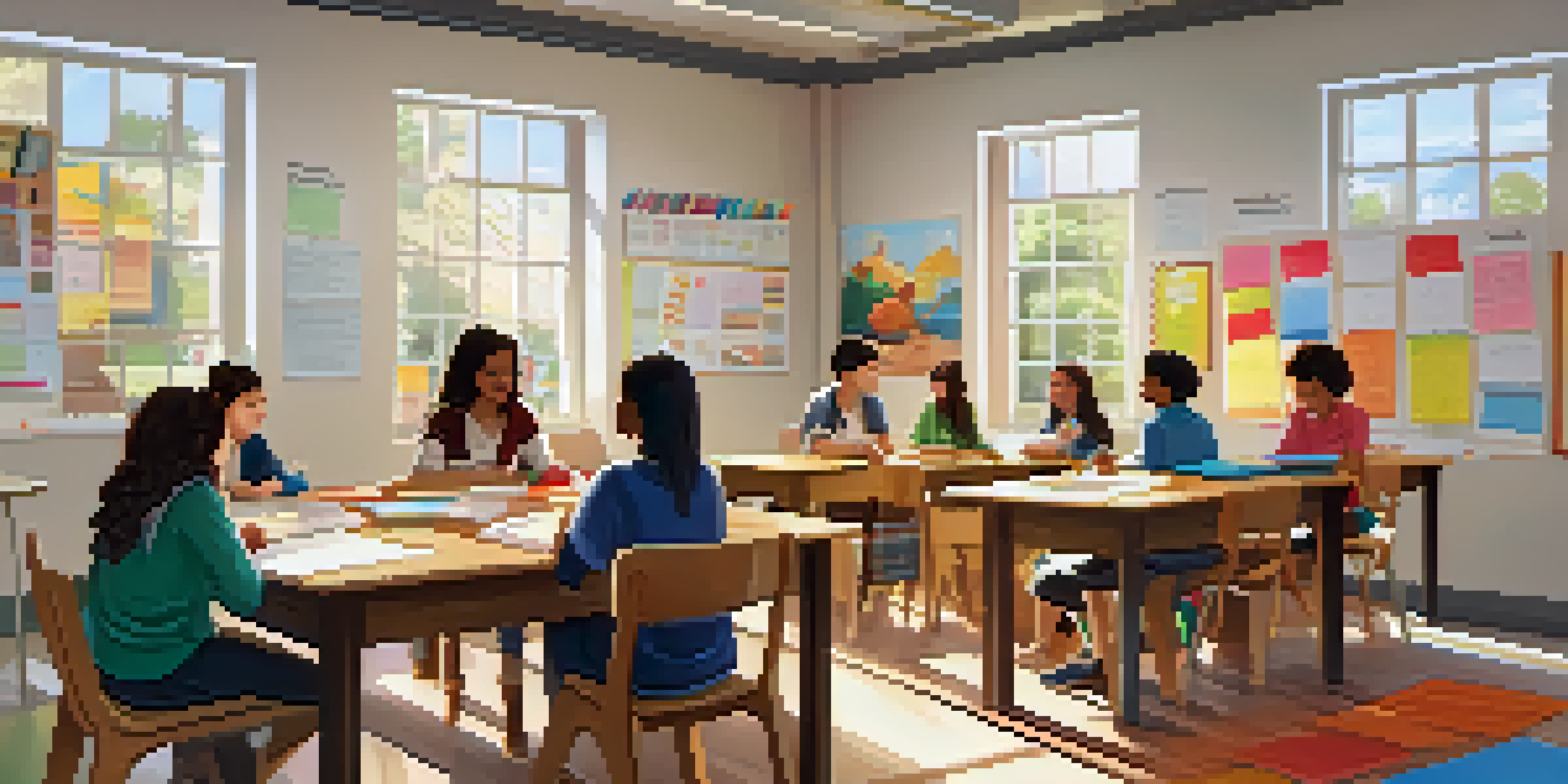Flipped Classroom: Engaging Students with Interactive Tech

Understanding the Flipped Classroom Concept
The flipped classroom is an innovative educational model that reverses traditional teaching methods. Instead of introducing new concepts during class time, students learn at home through videos or readings, while class time is reserved for discussions and interactive activities. This approach empowers students to learn at their own pace, making it easier to grasp challenging material without the pressure of keeping up with peers.
In a flipped classroom, students take responsibility for their own learning and come to class prepared to engage in deeper discussions.
Imagine cooking a new recipe: you watch a video tutorial at home, gather your ingredients, and then invite friends over to cook together. This collaboration mirrors the classroom experience, where students can apply their knowledge through hands-on learning and peer interaction. The flipped classroom encourages active participation, transforming students from passive recipients of information into engaged learners.
Ultimately, this model fosters deeper understanding as students come prepared with questions and insights. By shifting the focus from lectures to collaborative learning, educators can create a more dynamic and supportive learning environment.
The Role of Interactive Technology in Learning
Interactive technology is a game-changer in the flipped classroom model. Tools like educational apps, interactive videos, and online discussion forums encourage students to engage with content in meaningful ways. These technologies not only support various learning styles but also make learning more enjoyable and accessible.

For example, platforms like Kahoot! and Quizlet allow educators to create quizzes and games that reinforce learning in a fun, competitive atmosphere. This gamification of education motivates students to participate actively, transforming assessment into an engaging experience. By integrating technology, teachers can keep students' attention and make lessons more dynamic.
Flipped Classroom Enhances Learning
This innovative model allows students to learn at their own pace at home, leading to deeper understanding and engagement during class activities.
Moreover, technology bridges the gap between students and educators, facilitating communication and feedback. With features like video conferencing and chat tools, students can seek help outside class hours, ensuring they remain supported in their learning journey.
Benefits of a Flipped Classroom Approach
Adopting the flipped classroom model comes with numerous advantages. One of the key benefits is that it promotes personalized learning, allowing students to progress at their own speed. This flexibility means that those who grasp concepts quickly can move ahead, while others can take the time they need to fully understand the material.
Technology is just a tool. In terms of getting the kids working together and motivating them, the teacher is the most important.
Additionally, the model enhances classroom engagement. When students arrive prepared, lessons can dive deeper into discussions and collaborative activities. This not only fosters critical thinking and problem-solving skills but also encourages students to take ownership of their learning.
Lastly, the flipped classroom cultivates a sense of community among students. As they work together on projects and share their insights, they build relationships that enhance their educational experience. The collaborative nature of this approach helps create a supportive environment where students feel comfortable sharing ideas and seeking help.
Challenges of Implementing a Flipped Classroom
While the flipped classroom model has many benefits, it also presents certain challenges. One major hurdle is ensuring that all students have access to the necessary technology at home. Without reliable internet or devices, some students may struggle to engage with the pre-class materials, leading to disparities in learning.
Moreover, not all students are accustomed to self-directed learning. Some may find it difficult to stay motivated or may not know how to effectively manage their time. Educators must provide guidance and support to help these students develop essential skills, such as goal-setting and time management.
Technology Boosts Interactive Learning
Tools like educational apps and online forums make learning more engaging and accessible, catering to various learning styles.
Lastly, teachers must invest time in creating high-quality, engaging instructional materials. This preparation can be time-consuming, and not all educators may have the resources or experience to produce effective content. Ongoing professional development and collaboration among educators can help address these challenges.
Key Strategies for Successful Implementation
To effectively implement a flipped classroom model, educators can adopt several key strategies. First, it’s essential to curate high-quality instructional materials that resonate with students. This could include engaging videos, interactive quizzes, or podcasts that cater to diverse learning preferences.
Additionally, building a supportive community is crucial. Teachers should encourage open communication and provide resources for students who may struggle with self-directed learning. This could involve creating online discussion groups or scheduling regular check-ins to offer guidance and support.
Lastly, it’s important to continually assess and refine the approach. Educators should solicit feedback from students to understand what works and what doesn’t, allowing them to adapt their strategies accordingly. This ongoing evaluation ensures that the flipped classroom remains effective and responsive to students’ needs.
Real-Life Examples of Flipped Classrooms
Many schools and educators have successfully adopted the flipped classroom model, showcasing its effectiveness. For instance, a high school math teacher might assign video lectures on algebra concepts for homework. In class, they facilitate hands-on problem-solving sessions, allowing students to apply what they’ve learned in a supportive environment.
Another inspiring example comes from a university biology course. The professor uses interactive simulations for students to explore complex biological processes at home. Then, during class, they engage in collaborative projects, applying their knowledge to real-world scenarios, which deepens their understanding.
Challenges in Flipped Classroom Setup
Implementing this model requires addressing technology access disparities and supporting students in developing self-directed learning skills.
These examples not only highlight the versatility of the flipped classroom but also demonstrate how it can be tailored to various subjects and educational levels. They show that when students are actively involved in their learning process, they are more likely to succeed.
The Future of Flipped Classrooms and Technology
As education continues to evolve, the flipped classroom model is poised to expand further. Advances in technology, such as virtual reality and artificial intelligence, offer exciting opportunities to enhance the learning experience. Imagine students exploring ancient civilizations through immersive VR experiences, all from the comfort of their homes.
Moreover, the growing trend of personalized learning is likely to complement the flipped classroom model. With the help of adaptive learning technologies, educators can tailor content to meet each student’s unique needs, ensuring that everyone receives the support they require.

In conclusion, the future of flipped classrooms looks promising. As technology advances and educators embrace innovative teaching methods, we can expect a more engaging, interactive, and effective learning environment that prepares students for success in the 21st century.